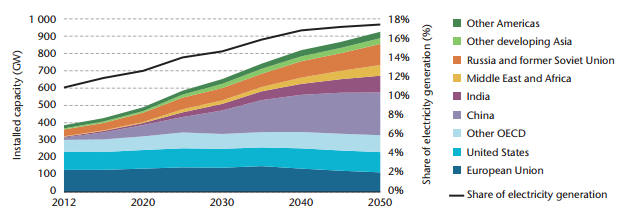According to a recent IAEA study, “The world’s nuclear power generating capacity is projected to continue to grow into 2030[1].” As part of the study the IAEA makes low and high projections of the global nuclear power generation capacity. The study shows that the low projection indicates 17 per cent growth in world total nuclear power capacity by 2030, while the high projection suggests a 94 per cent growth, nearly a doubling in global generation capacity.[1] In addition, according to the IEA nuclear energy still remains a proven low-carbon source of electricity despite the additional challenges in the face of the Fukushima Daiichi accident and many countries have reaffirmed the importance of nuclear energy within their domestic energy strategies.[2]
According to the IAEA, projections for nuclear energy growth has slowed by not reversed. In particular the current low price of natural gas and the on-going financial crisis presents challenges for capital intensive projects such as nuclear power.[2] However, the report also states, “In the long run, nuclear generating capacity is expected to play an important role in the energy mix due to growth in population and in demand for electricity in the developing world, as well as climate change concerns, security of energy supply and price volatility for other fuels.[2]” Furthermore, In the United States, more than 70% of operating reactors have been granted a 20-year license extension that allows reactors to operate for up to 60 years.[2] The same trend has been seen in Europe.
In a separate study conducted by the IEA a vision of nuclear energy development to the year 2050 was conducted based off of the 2°C Scenario (2DS). The 2DS scenario describes an energy stagey that is consistent with emissions that would give an 80% chance of limiting average global temperature increase to 2°C.[1] In the study the share of nuclear power in global electricity production is projected to rise from 11% to 17%.[1] The regional distribution of nuclear energy can be seen below.
According to the study the growth in nuclear capacity will be led by China, which under the 2DS assumptions will have twice the installed nuclear capacity of the United States by 2050. [1] Additionally, other growth countries in nuclear energy will likely be India, South Africa, and the Middle East.
Furthermore, the IEA projection states, “The contribution of nuclear energy to decarbonizing the electricity would result in annual CO2 emission reductions of 2.5 Gt CO2.[1] As a result nuclear energy plays an important role in providing reliable, low-carbon electricity to most regions of the world as seen below.[1]
As illustrated by both the IEA and the IAEA nuclear energy has the potential to provide a reliable and clean source of energy to nations around the world, despite the potential dangers and high up-front costs associated with the process. As a result, research and development of nuclear energy should be pursued to meet the goals outlined by the IEA nuclear technology road map.
(Composed by Ivan Basurto, Edited by Dan Kervick)
References
1. Agency, I. A. (2013, September 24). IAEA Issues Projections for Nuclear Power from 2020 to 2050. Retrieved from International Atomic Energy Agency : https://www.iaea.org/newscenter/news/iaea-issues-projections-nuclear-power-2020-2050
2. Agency, I. E. (2015). Technology Roadmap: Nuclear Energy . Retrieved from International Energy Agency : https://www.iea.org/publications/freepublications/publication/TechnologyRoadmapNuclearEnergy.pdf

